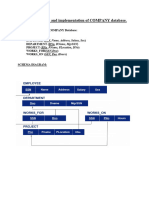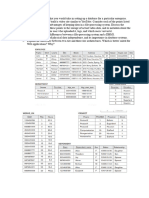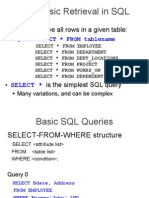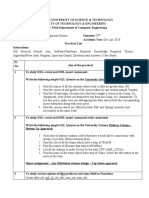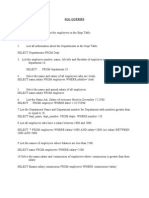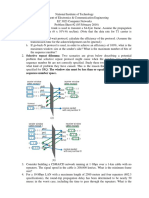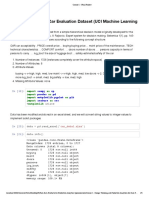Assignment #4
Uploaded by
Crentsil KwayieAssignment #4
Uploaded by
Crentsil KwayieRelational Database
CS 3520 Database Theory
HW # 4
1. Create the tables for the company database and enter the data as given to you (Handout).
2. Print all your tables to make sure you have entered correct data.
3. Write the following queries in Oracle Express Edition and run them using the company
database. For each query you need to show:
The English statement
The SQL statement
The result of the query.
The Queries are:
Q 0. Retrieve the birth date and address of the employee(s) whose name is:
‘John B. Smith’.
Select Bdate, address from Employee where Fname = 'John' AND Minit = 'B'
AND Lname = 'Smith';
Q 1. Retrieve the birth date and address of the employee(s) who work for the:
‘Research’ department.
Select Bdate, address from Employee where Dno = '5';
Q 2. For every project located in ‘Stafford’, list the project number, the controlling
department number and the department manager’s last name, address and birth
date.
Select p.Pnumber, p.Dnum, e.Lname, e.Address, e.Bdate from Project p JOIN
Department d on p.Dnum = d.Dnumber JOIN Employee e on d.Mgr_ssn = e.Ssn where
p.Plocation = 'Stafford';
Q 3. Retrieve all employees whose address is in Houston, Texas.
Select * from Employee where Address LIKE '%Houston%';
Q 4. Make a list of all project numbers for projects that involve an employee whose last
name is ‘Smith’ either as a worker or as a manager of the department that controls
the project.
Select p.Pnumber from Project p JOIN Department d on p.Dnum = d.Dnumber
JOIN Works_On w on p.Pnumber = w.Pno JOIN Employee e on w.Essn = e.Ssn
where e.Lname = 'Smith' OR d.Mgr_ssn = '123456789';
Q 5. Find all employees who were born during the 1950s.
select * from Employee e where e.Bdate >= '01/01/1950' AND e.Bdate <
'01/01/1960';
Q 6. Retrieve all employees in department 5 whose salary is between $30000 and
$40000.
Select e.* from Employee e WHERE TO_NUMBER(e.salary) >30000 AND
TO_NUMBER(e.salary) < 40000 AND e.Dno = '5';
Q 7. Show the resulting salaries if every employee working on the ‘ProductX’ project is
given a 10 percent raise.
Select e.Ssn, salary*1.10 from Employee e JOIN Works_ON w on e.Ssn = w.Essn
WHERE w.Pno = 1;
Q 8. Retrieve a list of employees and the projects they are working on, ordered by
department and, within each department, ordered alphabetically by last name, first
name.
Select w.Pno, e.Lname,e.Fname from Employee e JOIN Works_On w on e.Ssn
= w.Essn ORDER BY TO_NUMBER(w.Pno) Asc, e.Lname ASC, e.Fname Asc;
Q 9. Retrieve the name of all employees who do not have supervisor.
Select e.Lname,e.Fname, e.Minit from Employee e Where e.Super_ssn is null;
Q10. Retrieve the social security numbers of all employees who work on project numbers
1, 2, or 3.
Select DISTINCT e.ssn FROM Employee e JOIN WORKS_ON w on e.Ssn =
w.Essn Where w.Pno = '1' OR w.Pno = '2' OR w.Pno = '3';
Q11. Find the sum of the salaries of all employees, the maximum salaries, the minimum
salaries and the average salaries.
Select MAX(salary), MIN(salary), AVG(salary), SUM(salary) from Employee;
Q12. Retrieve (find) the number of employees in the ‘Research’ department.
Select Count(*) "Employees In Research" from Employee WHERE Dno = '5' ;
Q13. For each project, retrieve the project number, the project name, and the number of
employees who work on that project.
Select p.Pnumber, p.Pname, COUNT(*) FROM Project p JOIN Works_ON w on
p.Pnumber = w.Pno GROUP BY P.Pnumber, p.Pname ;
Q14. For each project on which more than two employees work, retrieve the project
number, the project name, and the number of employees who work on the project.
Select p.Pnumber, p.Pname, COUNT(*) FROM Project p JOIN Works_ON w on
p.Pnumber = w.Pno GROUP BY P.Pnumber, p.Pname HAVING COUNT(*) > 2;
Q15. For each project retrieve the project number, the project name, and the number of
employees from department 5 who work on the project.
Select p.Pnumber, p.Pname, COUNT(*) FROM Project p JOIN Works_ON w on
p.Pnumber = w.Pno JOIN Employee e on w.Essn = e.ssn WHERE e.Dno = '5'
GROUP BY P.Pnumber, p.Pname;
You might also like
- ASSINGNEMENT On Employee, Department, Dept - Location, Dept - MGR, Project, Works - On, Dependent100% (1)ASSINGNEMENT On Employee, Department, Dept - Location, Dept - MGR, Project, Works - On, Dependent10 pages
- Question 1: Make A List of Project Numbers For Projects That Involve An Employee Whose Last Name Is Smith', Either As A Worker or As A Manager of The Department That Controls The Project100% (1)Question 1: Make A List of Project Numbers For Projects That Involve An Employee Whose Last Name Is Smith', Either As A Worker or As A Manager of The Department That Controls The Project6 pages
- Dbms Lab Assignment-04:: Karthikeyan M: 20BCE0145No ratings yetDbms Lab Assignment-04:: Karthikeyan M: 20BCE014517 pages
- Rdbms and SQL: Name:Ibrahim Sameer V S REG NO:17BCA0062100% (1)Rdbms and SQL: Name:Ibrahim Sameer V S REG NO:17BCA006233 pages
- FALLSEM2022-23 CSC2003 ELA VL2022230100968 Reference Material I 21-07-2022 Lab-Cycle-Sheet-DBMS-CSC2003No ratings yetFALLSEM2022-23 CSC2003 ELA VL2022230100968 Reference Material I 21-07-2022 Lab-Cycle-Sheet-DBMS-CSC20035 pages
- Lectuer-6 Database Design and Applications: BITS PilaniNo ratings yetLectuer-6 Database Design and Applications: BITS Pilani21 pages
- BE in Computer Engineering Semester-3, Year 2020-21: Database Management System (3130703)No ratings yetBE in Computer Engineering Semester-3, Year 2020-21: Database Management System (3130703)54 pages
- Select First - Name "First Name", Last - Name "Last Name" From Employees Limit 20No ratings yetSelect First - Name "First Name", Last - Name "Last Name" From Employees Limit 2014 pages
- SQL Query Slides: Sharif University of Technology Database SystemsNo ratings yetSQL Query Slides: Sharif University of Technology Database Systems23 pages
- (Pucit) : Punjab University Collefe of Information Technology Database Systems Assignment 2No ratings yet(Pucit) : Punjab University Collefe of Information Technology Database Systems Assignment 25 pages
- 1729222642818_64f1eaa426423c287faa5b10_DBI_Lab4_2024_Fall_QuestionNo ratings yet1729222642818_64f1eaa426423c287faa5b10_DBI_Lab4_2024_Fall_Question6 pages
- Tutorial5 - Wizard - Data Access With ADO - NET - 2021No ratings yetTutorial5 - Wizard - Data Access With ADO - NET - 202144 pages
- UMS BS CyberSecurity Proposal DRAFT 2 21 15No ratings yetUMS BS CyberSecurity Proposal DRAFT 2 21 1585 pages
- Tutorial4 - Wizard - Multiple Tables and Parameterized Queries - 2022No ratings yetTutorial4 - Wizard - Multiple Tables and Parameterized Queries - 202255 pages
- A Tool Selection Framework For Cross Platform Mobile App DevelopmentNo ratings yetA Tool Selection Framework For Cross Platform Mobile App Development119 pages
- Final ENCE 455 - ADVANCED MICROPROCESSOR SYSTEMS AND INTERFACING EXAMS - NOV 2021No ratings yetFinal ENCE 455 - ADVANCED MICROPROCESSOR SYSTEMS AND INTERFACING EXAMS - NOV 20218 pages
- 101 C Sun Avenue NE Albuquerque, NM, 87109, USA Phone: 1.505.341.3228 Fax: 1.505.856-8267No ratings yet101 C Sun Avenue NE Albuquerque, NM, 87109, USA Phone: 1.505.341.3228 Fax: 1.505.856-82672 pages
- Chapter 1: Introduction To Database Management SystemNo ratings yetChapter 1: Introduction To Database Management System47 pages
- Software Architecture and Design of Large Scale Systems - WorkbookNo ratings yetSoftware Architecture and Design of Large Scale Systems - Workbook44 pages
- Isim Database Schema Reference Guide PDFNo ratings yetIsim Database Schema Reference Guide PDF288 pages
- About The Dataset - Car Evaluation Dataset (UCI Machine Learning RepositoryNo ratings yetAbout The Dataset - Car Evaluation Dataset (UCI Machine Learning Repository5 pages
- OneFS Built-In Migration Tools Guide PDFNo ratings yetOneFS Built-In Migration Tools Guide PDF54 pages
- CH 18 Virtual Circuit Networks Frame Relay and ATM Multiple Choice Questions and AnswersNo ratings yetCH 18 Virtual Circuit Networks Frame Relay and ATM Multiple Choice Questions and Answers9 pages
- Full Bandwidth Management Parent Queue Tree: Internet ConnectionNo ratings yetFull Bandwidth Management Parent Queue Tree: Internet Connection12 pages
- Data Communication and Network Quiz 1 Jan Mark B09210037No ratings yetData Communication and Network Quiz 1 Jan Mark B092100371 page
- VLSI Architectures For Iterative Decoders in Magnetic Recording ChannelsNo ratings yetVLSI Architectures For Iterative Decoders in Magnetic Recording Channels8 pages
- ASSINGNEMENT On Employee, Department, Dept - Location, Dept - MGR, Project, Works - On, DependentASSINGNEMENT On Employee, Department, Dept - Location, Dept - MGR, Project, Works - On, Dependent
- Question 1: Make A List of Project Numbers For Projects That Involve An Employee Whose Last Name Is Smith', Either As A Worker or As A Manager of The Department That Controls The ProjectQuestion 1: Make A List of Project Numbers For Projects That Involve An Employee Whose Last Name Is Smith', Either As A Worker or As A Manager of The Department That Controls The Project
- Rdbms and SQL: Name:Ibrahim Sameer V S REG NO:17BCA0062Rdbms and SQL: Name:Ibrahim Sameer V S REG NO:17BCA0062
- FALLSEM2022-23 CSC2003 ELA VL2022230100968 Reference Material I 21-07-2022 Lab-Cycle-Sheet-DBMS-CSC2003FALLSEM2022-23 CSC2003 ELA VL2022230100968 Reference Material I 21-07-2022 Lab-Cycle-Sheet-DBMS-CSC2003
- Lectuer-6 Database Design and Applications: BITS PilaniLectuer-6 Database Design and Applications: BITS Pilani
- BE in Computer Engineering Semester-3, Year 2020-21: Database Management System (3130703)BE in Computer Engineering Semester-3, Year 2020-21: Database Management System (3130703)
- Select First - Name "First Name", Last - Name "Last Name" From Employees Limit 20Select First - Name "First Name", Last - Name "Last Name" From Employees Limit 20
- SQL Query Slides: Sharif University of Technology Database SystemsSQL Query Slides: Sharif University of Technology Database Systems
- (Pucit) : Punjab University Collefe of Information Technology Database Systems Assignment 2(Pucit) : Punjab University Collefe of Information Technology Database Systems Assignment 2
- 1729222642818_64f1eaa426423c287faa5b10_DBI_Lab4_2024_Fall_Question1729222642818_64f1eaa426423c287faa5b10_DBI_Lab4_2024_Fall_Question
- Tutorial5 - Wizard - Data Access With ADO - NET - 2021Tutorial5 - Wizard - Data Access With ADO - NET - 2021
- Tutorial4 - Wizard - Multiple Tables and Parameterized Queries - 2022Tutorial4 - Wizard - Multiple Tables and Parameterized Queries - 2022
- A Tool Selection Framework For Cross Platform Mobile App DevelopmentA Tool Selection Framework For Cross Platform Mobile App Development
- Final ENCE 455 - ADVANCED MICROPROCESSOR SYSTEMS AND INTERFACING EXAMS - NOV 2021Final ENCE 455 - ADVANCED MICROPROCESSOR SYSTEMS AND INTERFACING EXAMS - NOV 2021
- 101 C Sun Avenue NE Albuquerque, NM, 87109, USA Phone: 1.505.341.3228 Fax: 1.505.856-8267101 C Sun Avenue NE Albuquerque, NM, 87109, USA Phone: 1.505.341.3228 Fax: 1.505.856-8267
- Chapter 1: Introduction To Database Management SystemChapter 1: Introduction To Database Management System
- Software Architecture and Design of Large Scale Systems - WorkbookSoftware Architecture and Design of Large Scale Systems - Workbook
- About The Dataset - Car Evaluation Dataset (UCI Machine Learning RepositoryAbout The Dataset - Car Evaluation Dataset (UCI Machine Learning Repository
- CH 18 Virtual Circuit Networks Frame Relay and ATM Multiple Choice Questions and AnswersCH 18 Virtual Circuit Networks Frame Relay and ATM Multiple Choice Questions and Answers
- Full Bandwidth Management Parent Queue Tree: Internet ConnectionFull Bandwidth Management Parent Queue Tree: Internet Connection
- Data Communication and Network Quiz 1 Jan Mark B09210037Data Communication and Network Quiz 1 Jan Mark B09210037
- VLSI Architectures For Iterative Decoders in Magnetic Recording ChannelsVLSI Architectures For Iterative Decoders in Magnetic Recording Channels










